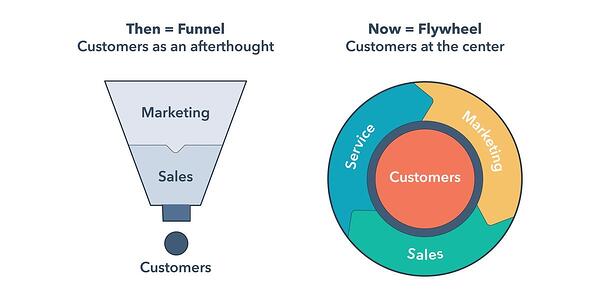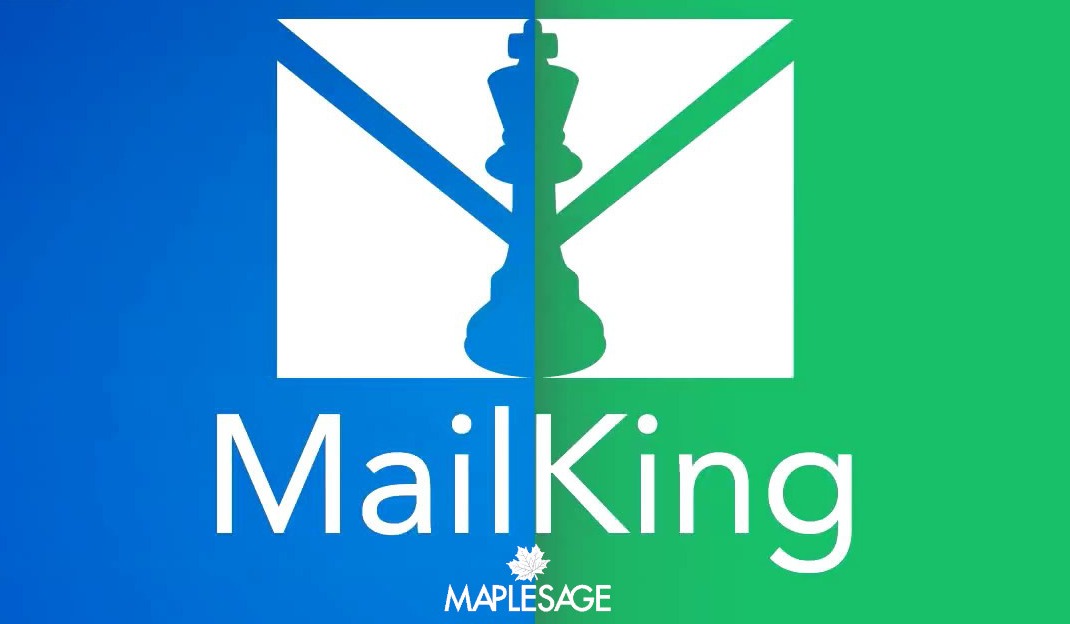Growth Strategies for 2020 - B2B Sales Framework Flywheel
As a sales professional and entrepreneur, I know funnels inside out and have used for good 18 years of my sale and marketing career, they are what convert leads into customers.
However, over the last few years, the relevancy of the funnel seems to have slowly died out, leaving room for a new, strategy to take its place.
I wasn't very surprised when HubSpot announced they are retiring the funnel and adopting the flywheel as the new model.
Though the thought of adopting something new to replace the trusted funnel was not very comforting, I decided to follow the bandwagon and started learning about the flywheel.
Turns out, they’re pretty amazing.
Trusted Funnel FrameWork
The funnel is as classic as a tool can get in marketing. This ubiquitous analogy represents the stages a prospective customer goes through on their buyer journey.
The stages are usually broken down into:
- Awareness
- Consideration
- Conversion
Some add loyalty and advocacy at the bottom of this funnel. Others add a note like “rinse and repeat.”
The top of the funnel is wide. Many people can become aware of your product, but not all will become interested.
The funnel gets narrower as the leads pass through the different stages. Only a small percentage of the initial prospects will actually take the desired action, usually a purchase. With this in mind, businesses have put a great deal of effort into filling the funnel with more leads. This process of “widening the funnel” finds more potential customers, eventually leading to more sales.
The funnel is helpful in visualizing the customer journey in specific steps.
However, in an era when trust in traditional sources has eroded — in government, media, and in companies and the marketing they employ — word-of-mouth from trusted peers wields greater clout than ever.
The funnel fails to capture momentum, it turns out Funnels lose the energy you put into them once you reach the bottom, but the flywheel is remarkable at storing and releasing energy.
What is Marketing Flywheel?
A mechanical flywheel that efficiently stores energy and can be used to increase a machine’s momentum. Invented by James Watt (yes, the guy whose name is on every lightbulb) over 200 years ago, a flywheel is simple a wheel or disc on an axis, that’s incredibly energy-efficient. The amount of energy it stores depends on how fast you spin it, how much friction there is, and the composition of the wheel itself -- how big it is and how much it weighs. Flywheels are used in cars, trains and power plants.
Much like an engine needs a flywheel to store energy, marketers need a marketing flywheel to garner the power of loyal customers. The flywheel is similar to the funnel in that it represents the customer journey in three main stages.

Hubspot coins the flywheel stages as:
- Attract
- Engage
- Delight
At the center of the wheel is the customer base. The rotation of the wheel is the growth of your business. Happy customers are the energy that fuels growth.
This marketing flywheel is inspired by Amazon’s flywheel business model, also known as Bezos’ Virtuous Cycle.
In a flywheel, growth and customers are the centers of every other process. Everything literally revolves around customer experience. Loyal customers are the energy that fuels all growth. Customers never fall out of the loop. They are not lost energy.
What makes a flywheel slow down? Friction. Friction points are processes that cause the customer inconvenience and put a damper on their experience.
The linear approach to measuring growth is a huge weakness. Funnels produce customers but don’t consider how those customers can help you grow. And all the momentum you built acquiring that customer? Gone. Each day, each month, and each quarter, we have to start new.
This isn’t just inefficient, it’s a major problem. Ignoring how customers can help you grow is perilous in today’s world.
Word of mouth has always been fundamental to great marketing, but look at the world we are living in today. Trust is at an all-time low, it’s harder to get distribution on Google and Facebook, and prospects are doing far more independent research than they ever have. With word of mouth being so crucial, losing the momentum you generate in creating a new customer is a real drag on your growth.
Whereas funnels lose their momentum at the bottom, flywheel leverages their momentum to keep spinning. Also, because they preserve momentum so well, all of the additional energy you add to spin it faster adds to the capacity of the whole.
A flywheel and a funnel are two mindsets:
Customers as an Output vs Input
With a funnel, customers are an output. They are lost energy. Many come in, many filters out, and only a few come out of the funnel. The few customers who took action are not part of the process of gaining new customers. Customer Success and Support teams handle interactions with customers after they buy. They’re not the concern of the Marketing team.
With a flywheel, customers are the most important input. They have stored energy that drives growth. They’re absolutely the concern of the Marketing team – you could even say they’re the marketing team’s secret weapon. Customer energy is what drives more people to become aware of favorite brands and continue on the cycle through engagement and delight.
End-Point vs Ongoing
With a funnel process, at the end of each quarter, a marketing team feels no momentum and has to start from scratch the following quarter. In other words, the success of driving new business last quarter doesn’t help reach this quarter’s lead goals.
With the flywheel, marketers recognize they already have assets with inbound marketing, SEO, social media engagement, and loyal customers. These assets are stored energy that keeps growth moving.
Awareness vs Delight
With a funnel, marketers need to focus on widening the funnel. This means that large amounts of investment are put into driving more people to become aware of their product and to acquire customers.
With a funnel, the emphasis is placed on the delight stage. Halligan says this is where the biggest return on your investment is today. Delight consists of great customer support, quality policy, enjoyable ads, and all things that bring joy to the customers.
Delight brings customers back for repeat purchases and gets them talking about your brand.
Flywheel In Action
Flywheel represents a circular process where customers feed growth. Hubspot as a company has invested more in customer marketing, more in customer advocacy, and more in creating delightful onboarding for new customers. They’ve also invested in an integrations ecosystem that helps customers do more and creates real value for people who adopt their suite of software.
Friction kills flywheel. They’ve made investments that systematically target their biggest points of friction: Great free software as an entry point, channels that help people connect now instead of later, a sales process that solves for prospects, and a broad range of customer education.
Actions marketers can take at each of the three stages.
Attract
This is where customers are drawn to your brand. This happens by creating engaging and useful content for the right people. Some practical example actions include:
- Traditional means (word of mouth, events, paid ads)
- Review Sites
- Customer testimonials
- Inbound marketing, with a focus on creating content that will interest your ideal customer profile (ICP), rather than broad clickbaity content
Engage
Engagement happens by creating meaningful relationships with clients. Businesses need to understand clients, their motivations, needs, and pain points. When companies truly empathize with clients, they can provide customers with solutions that satisfy them.
Some examples include:
- Blog with helpful how-to resources
- Social Media polls and sharing articles your customers could really benefit from reading
- Podcasts
- Interactive content
- Chat Boxes, text message follow-up, call center, etc.
Delight
Delight is bringing joy to your customers along their journey. It involves giving them an impactful experience that they will want to promote your brand. They will be the customer advocates who bring more into the flywheel. Examples include
- Return policies
- Free shipping and other shipping options
- Reward programs
- Regular check-ins
- High-quality customer support
- Recognizing and featuring their successes – showcasing them to the rest of the world
Negative Force to the Flywheel: Friction

Through all these stages, it is important to identify friction. Friction is what makes the customer momentum slow down. This can be misalignment between departments, hiccups in the pipeline, or whatever is killing your customers’ joy. Make sure all silos are on the same page with how customers will be supported, reduce handoffs, and take action to reduce customer churn. Above all else, make sure you’re actively listening for customer feedback, so that you can identify friction wherever it may be.
Why the Flywheel Framework Matters
You’re thinking, we just debating jargon for the sake of it!

No -- when you think of your business as a flywheel instead of a funnel, you make different decisions. Using Your Flywheel as a Growth Tool
Three factors that dictate how much momentum your flywheel contains:
- How fast you spin it
- How much friction there is
- How it’s composed -- how big it is and how much it weighs
The best teams will have strategies for all three.
Let’s start with how fast you spin it. The speed of your flywheel is increased by applying more force in the areas where it can have the biggest impact. In a funnel model, all force is applied to attract and acquire customers. In a flywheel model, you also apply force to delight those customers and make them successful.
Since you’re applying all sorts of force all-around your flywheel, ensure that none of your investments oppose each other. A lack of alignment between sales and customer success, for instance, can create unhappy customers and slow your flywheel when they churn.
Classic sales and marketing misalignment is another area where the flywheel can slow. Alignment is crucial.
You can reduce friction by finding the inefficiencies where your customers are losing momentum, and making them better.
Improving conversion rates, delighting customers at scale, and addressing issues that cause you to churn customers increase the speed of your flywheel.
The other crucial area to consider when thinking about friction is how your teams are organized. Silos, handoffs, and specialization all create friction.
-16.png)
As you successfully increase speed and decrease friction, you will create more delighted customers.
-11.png)
More delighted customers mean a “heavier” wheel and one that produces more energy when spun. Said another way, your flywheel produces more growth as your customer count increases. If you can add “density” to those customers, by getting them to adopt more of your products or be more “sticky,” even more momentum and growth can be achieved.
Applying Funnel In Your Business
In his keynote at INBOUND 2018, Halligan explained the flywheel, and why it’s a powerful new growth model. In his keynote, he assigned the following “homework” to attendees:
- Identify the core flywheel metrics your company tracks
- Identify your company’s forces by flywheel stage
- Re-draw those forces to maximize delight and word of mouth
- Identify points of friction between your customers and your employees, and points of handoff between internal teams, that affect customer experience
- Re-align those points of friction to better serve the customer through automation, shared goals, or a reorganization
To help you build your flywheel and turn it into a growth tool for your business, here is a completed sample homework for HubSpot’s flywheel and provided as a guide for you to do the same.
Change can be difficult when overhauling a tool so integral to a marketing team. If your business is B2C, the train is about to leave the station. You’ve got to get 90% of the friction out of your model. If you’re B2B, the train is parked in the station, but it’s leaving soon.
Funnels have served their purposes for a long time. Time has come for business to ditch Funnel and adopting the Flywheel To Grow Better.
Helpful links to the homework templates:
- Google Slides -- you won’t be able to edit this file directly, so make a copy for an editable version
- PowerPoint
Assignment 1: Measuring the Flywheel
The first task is understanding the status quo of your flywheel.
At each stage depicted below -- attract, engage, and delight
Here’s how we think about each stage:
Attract: Attracting is about using your expertise to create content and conversations that start meaningful relationships with the right people.
Engage: Engaging is about building lasting relationships with people by providing insights and solutions that align with their roadblocks and goals.
Delight: Delighting is about providing an outstanding experience that adds real value, empowers people to reach their goals, and become promoters of your company.
To determine the health of our flywheel, as yourselves two questions:
- What investments are we making at each stage of the flywheel?
- How are we measuring the success or failure of those investments?
Part 1: Mapping your go-to-market strategy
In this step, identify the core activity or program your company has invested in to uphold each of your Attract, Engage, and Delight commitments. Fill out each activity corresponding to its flywheel stage.
You may find that one flywheel isn’t enough to encompass all your company does. That’s perfectly okay -- there are probably multiple flywheels spinning in parallel. The purpose of this exercise is to distill the core parts of your business, so focus on the most important activity at each stage.
Part 2: Measuring success
In this step, identify the most important metric for each activity. Make a note of conversion rates between each stage here as well -- this measures the friction in your flywheel.
Then, record (either month-over-month or year-over-year) how much you added or lost in that bucket, and your total number.
Attract: Our topline metric here is monthly website traffic. We measure how much traffic we gain month-over-month.
Engage: HubSpot’s flywheel moves visitors through the “Engage” stage in two steps.
Delight: Track the number of customers who are promoters -- that is, how many customers say they would recommend.
Assignment 2: Maximizing Delight
When you’re just starting to grow a business, most of your resources will be focused on the attract and engage parts of your flywheel. Rightly so -- it takes a lot of investment to build enough momentum to get your flywheel spinning. But once it is, consider whether your resources could be better spent focusing on delighting customers.
That’s because once your flywheel is spinning, momentum comes from retaining customers and transforming them into promoters who will advocate for your brand and even bring you new business.
In this assignment, examine the “forces” -- activities and programs -- that currently move your customers through your flywheel, and consider whether they are designed to serve your process or your customers’ needs. Then, list out what changes you’d need to make to those forces in 2020 to help maximize delight.
Assignment 3: Reducing Friction
There are many ways to reduce friction in your flywheel.
One way is to smooth out common friction points, like your conversion rates between different phases, how many customers become successful, and how many churns. It’s not too difficult to identify this type of weakness, because you’re dealing with metrics that are largely isolated from one another.
It’s harder to see the forest for the trees and examine how the overall structure of your company might be contributing to drag and friction. So for this assignment, we’re going to focus on one of the thornier sources of friction at your company: Your organizational chart. Siloed work and poor handoff between teams are some of the biggest areas of friction in most flywheels.
You can break this down into four steps:
- Where are your points of friction?
- What can be automated?
- What can be addressed through shared goals?
- What can be addressed through team reorganization?
We’ll go step by step here.
Step 1: Identify friction
Where is there drag in your organization?
Externally, think about the complaints you hear from customers and prospects -- where do they have difficulty interacting with your company?
Internally, consider which metrics you struggle to move despite repeated efforts, processes that take longer than they should, and sources of common problems.
Step 2: Automate repeatable tasks
Consider the activities your customers and prospects want to do but are complex for humans to execute. In addition, look for the repetitive, mechanical tasks that fall on your team’s plates -- can you free up their time for work that’s more valuable for your customers? Also, consider which parts of your go-to-market currently rely purely on your employees to function but could be supplemented by automation.
Step 3: Reset goals to bridge teams
Often, friction exists because two teams are moving in opposite directions. For example, marketing is traditionally goaled on an overall lead generation number -- but optimizing for lead quantity doesn’t always lead to good-fit customers.
Some of your biggest friction points can be smoothed by re-setting goals or introducing processes that re-orient teams in the same direction.
Step 4: Restructure teams
Within every organization, there are problems that can’t be fixed by automation or goal realignment. In those cases, a reorganization may be necessary.
Some questions you can use to self-assess here are:
- Do employees who work in the same functions sit across different departments?
- Are teams over-specialized?
- If your organization has a systemic blind spot, do you have a team dedicated to solving it?



-32eb7d.png?width=300&name=The%20Hard%20Truth%20About%20Acquisition%20Costs%20(and%20How%20Your%20Customers%20Can%20Save%20You)-32.png)

ed6a.png?width=600&name=goal-setting-1955806_1920%20(1).png)

-33.png)


